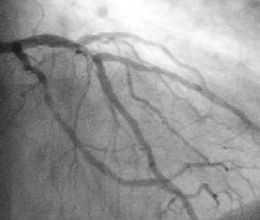Coronary Angiography
 Coronary angiography is the most direct way of finding out if there is any obstruction of the coronary arteries.
Coronary angiography is the most direct way of finding out if there is any obstruction of the coronary arteries.
In order to take pictures of the coronary arteries, a radio-opaque dye needs to be injected directly into them, and X-ray images then taken. To do this, a fine tube known as a catheter has to be passed to the heart, usually from the femoral artery in the groin (but sometimes also from an artery at the wrist or elbow). A local anaesthetic is injected to numb the area before the catheter is inserted.
The catheter is then guided up the artery until it reaches the heart. Some patients may experience a few palpitations when the catheter reaches the heart. This is quite normal. Once in position, the doctor injects a dye into the coronary artery, and X-ray pictures are taken from various angles. It is common to experience slight facial flushing as the dye is injected. You may also be asked to hold your breath for several seconds whist the X-rays are taken.
Depending on what your doctor discovers during your angiogram, you may have additional catheter procedures at the same time, such as a balloon angioplasty or a stent placement to open up a narrowed artery.
What Are The Risks?
An angiogram is considered an invasive procedure, and because there's a small risk of complications, it is usually done after non-invasive heart tests have been performed (such as an ECG, echocardiogram, exercise stress test).
Other than the obvious risk of exposure to X-rays, other more serious potential complications, although rare, include:
• Heart attack
• Stroke
• Irregular heart rhythms (arrhythmias)
• Allergic reactions to the dye or medications used during the procedure
• A tear in the catheterized artery
• Excessive bleeding
• Infection
• Blood clots
The Results
A coronary angiogram will determine whether or not you have coronary heart disease, and if so, how severe it is.
It will show:
• How many of your coronary arteries are blocked or narrowed by fatty plaques (atherosclerosis)
• Where the blockages are located in your coronary arteries
• How much blood flow is blocked through your blood vessels
• Check the results of previous coronary bypass surgery, angioplasty
This information will help your doctor determine what treatment is best for you and how much danger your heart condition poses to your health. Depending on the number of vessels affected and the extent of the affected part, your doctor will be able to advise you on which method of treatment is best suited ie. angioplasty or bypass surgery.
Further Reading
The article above is meant to provide general information and does not replace a doctor's consultation.
Please see your doctor for professional advice.
